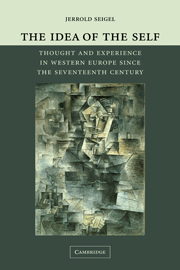Book contents
- Frontmatter
- Contents
- Acknowledgments
- PART I INTRODUCTORY
- PART II BRITISH MODERNITY
- PART III SOCIETY AND SELF-KNOWLEDGE: FRANCE FROM OLD REGIME TO RESTORATION
- PART IV THE WORLD AND THE SELF IN GERMAN IDEALISM
- PART V MODERN VISIONS AND ILLUSIONS
- 13 Dejection, insight, and self-making: Coleridge and Mill
- 14 From cultivated subjectivity to the culte du moi: polarities of self-formation in nineteenth-century France
- 15 Society and selfhood reconciled: Janet, Fouillé, and Bergson
- 16 Will, reflection, and self-overcoming: Schopenhauer and Nietzsche
- 17 Being and transcendence: Heidegger
- 18 Deaths and transfigurations of the self: Foucault and Derrida
- 19 Epilogue
- Notes
- Index
15 - Society and selfhood reconciled: Janet, Fouillé, and Bergson
Published online by Cambridge University Press: 05 June 2012
- Frontmatter
- Contents
- Acknowledgments
- PART I INTRODUCTORY
- PART II BRITISH MODERNITY
- PART III SOCIETY AND SELF-KNOWLEDGE: FRANCE FROM OLD REGIME TO RESTORATION
- PART IV THE WORLD AND THE SELF IN GERMAN IDEALISM
- PART V MODERN VISIONS AND ILLUSIONS
- 13 Dejection, insight, and self-making: Coleridge and Mill
- 14 From cultivated subjectivity to the culte du moi: polarities of self-formation in nineteenth-century France
- 15 Society and selfhood reconciled: Janet, Fouillé, and Bergson
- 16 Will, reflection, and self-overcoming: Schopenhauer and Nietzsche
- 17 Being and transcendence: Heidegger
- 18 Deaths and transfigurations of the self: Foucault and Derrida
- 19 Epilogue
- Notes
- Index
Summary
The starkly opposed solutions to establishing a satisfying mode of self-existence represented in France by Cousin and Durkheim on the one hand, and by Rimbaud, Huysmans, and Barrès on the other, would remain as alternatives even in the twentieth century. The power of collective institutions to form individuals along pre-established lines persisted in the highly centralized educational system, while the tradition of resistance to it was renewed both in new forms of political opposition and in the development of avant-garde aesthetic movements that took inspiration from Rimbaud and Mallarmé. Foucault and Derrida would draw energy from all those currents. Even so, not all French thinkers, much less ordinary citizens, ranged themselves at one or the other of these poles. By the end of the 1880s a number of writers and theorists were finding ways to put social relations and personal existence into more mutually supportive configurations. One of the elements they employed in doing so was a notion some of them shared with Barrès, and with the kind of “decadent” consciousness analyzed by Paul Bourget, namely the idea that the self was not singular but multiple. Barrès pictured his hero as living a plurality of moral lives, thus attributing to him on a personal level the same absence of coordination that Bourget saw as characteristic of society in a state of decadence, with each individual component going along on its own independent path. Contemporary psychologists were offering similar views of the self in the last decades of the nineteenth century.
- Type
- Chapter
- Information
- The Idea of the SelfThought and Experience in Western Europe since the Seventeenth Century, pp. 508 - 536Publisher: Cambridge University PressPrint publication year: 2005

